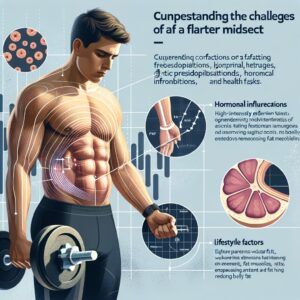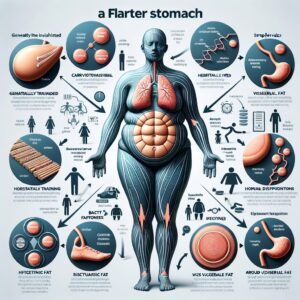This ultimate guide delves into the multifaceted journey toward achieving a flatter midsection, breaking down the challenges of belly fat while outlining effective strategies centered on targeted exercise routines, optimized nutrition, and debunking common myths.
By exploring why belly fat is particularly stubborn—from genetic predispositions and hormonal influences to lifestyle factors—and by highlighting tailored workout regimens and smart dietary tweaks, this guide prepares you to address both visceral and side belly fat methodically, ensuring your pursuit of a leaner, healthier core is both informed and sustainable.

Your future is calling! Answer at Great Life Worldwide and discover why it’s the perfect fit for you. Free tour available – act fast!
1. Understanding the Challenges of Belly Fat
Belly fat presents unique challenges that impede progress toward a lean midsection. Its stubborn nature results from a combination of genetic predispositions, hormonal influences, and lifestyle factors. Individuals with a family history of central obesity may experience additional difficulty due to inherited fat distribution patterns that favor the abdominal area.
Hormonal fluctuations, particularly involving cortisol and insulin, further exacerbate fat accumulation around the waist. Increased stress levels and disrupted sleep patterns can lead to hormonal imbalances that reinforce this tendency, making targeted fat loss more challenging.
Visceral fat, which surrounds internal organs, poses significant health risks and is metabolically active. Research indicates that excess visceral fat contributes to inflammation and increases the likelihood of cardiovascular disease, diabetes, and other metabolic disorders. Unlike subcutaneous fat, visceral fat is highly responsive to hormonal signals, rendering typical weight loss strategies less effective in reducing abdominal fat alone. As a result, many individuals struggle to see substantial improvements in their midsection despite overall body weight reduction.
Recognizing these challenges is essential for developing a comprehensive fat loss strategy. Effective approaches typically incorporate balanced nutrition, consistent exercise, and stress management to address the hormonal and physiological factors at play. Professionals advise that combining lifestyle modifications with targeted interventions can help reduce belly fat over time. By understanding the underlying reasons behind stubborn abdominal fat, individuals are better equipped to set realistic expectations and pursue strategies that promote long-term metabolic health and overall wellness.
Additional factors further complicate the battle against belly fat. Sedentary lifestyles, coupled with readily available processed foods, contribute to energy imbalances that favor abdominal fat storage. Moreover, age-related metabolic slowdowns can make fat loss more challenging as body composition changes over time. Addressing these factors with a holistic approach is paramount for sustainable results. A targeted, multifaceted strategy is absolutely essential immediately.

Dare to dream bigger! Discover your true potential at Great Life Worldwide. Learn why it’s your ticket to success. Free tour available now!
2. The Role of Exercise: Which Workouts Target Belly Fat Best
An effective exercise regimen is a cornerstone strategy for reducing belly fat. Research indicates that incorporating a mix of both cardiovascular and resistance training exercises yields the most significant benefits when targeting stubborn abdominal fat.
Due to its metabolic boosting properties, high-intensity interval training (HIIT) has emerged as a highly recommended approach. It combines short bursts of intense activity with recovery periods, effectively enhancing caloric burn during and after workouts. This results in improved fat metabolism and a reduction in visceral fat stores.
In addition, moderate-intensity exercises, such as brisk walking and steady-state cycling, help maintain continuous fat oxidation, supporting overall weight management. Resistance training plays a complementary role by preserving lean muscle mass, which ultimately increases the body’s resting metabolic rate. Building and maintaining muscle tissue is essential, as it contributes to higher daily energy expenditure even at rest. Incorporating compound movements like squats, deadlifts, and bench presses engages multiple muscle groups simultaneously and further supports a metabolic advantage.
Moreover, core-focused exercises improve muscle tone and stability but should be integrated with full-body workouts rather than performed in isolation. Consistency in a diverse workout routine allows the body to adapt progressively, ensuring ongoing improvements in fat loss efficiency. It’s advisable to integrate periods of active recovery and flexibility routines to prevent burnout while maintaining overall joint health.
Ultimately, the combination of HIIT, moderate cardio, and resistance training offers a balanced and sustainable approach for targeting belly fat. By focusing on these exercise modalities, individuals are better positioned to overcome the unique challenges associated with abdominal fat loss while promoting healthier body composition and long-term fitness success.
Precision in workout planning and executing varying intensities is vital to diminishing belly fat effectively. Regular monitoring of progress and adjusting exercise parameters ensures continued metabolic stimulation, promoting efficient fat burning and enhanced core strength.

Time for a change? Make it count! Head to Great Life Worldwide and explore its amazing opportunities. Take the free tour before time runs out!
3. Breaking Down Side Belly Fat: Why It’s Hard to Lose and How to Tackle It
Excess fat accumulation along the sides of the midsection presents a stubborn challenge for individuals striving for a flatter abdomen. Unlike fat deposits in other areas, side belly fat—often concentrated in the oblique region—is notoriously resistant to standard weight loss efforts.
This resistance can be attributed to a combination of genetic factors, hormonal imbalances, and lifestyle habits that favor fat storage over mobilization. While regular exercise and a balanced diet contribute to overall body fat reduction, localized fat pockets, particularly on the sides, require a comprehensive approach.
A multi-pronged strategy is essential for addressing side belly fat. Incorporating both cardiovascular and strength training exercises can enhance metabolism and promote more efficient fat burning throughout the body. Core-specific workouts, such as side planks and rotational movements, help tone the oblique muscles, providing a more defined midsection even as overall fat loss occurs. However, one should note that spot reduction remains a debated concept; rather, a consistent exercise regimen supports gradual loss across multiple areas.
Nutritional adjustments are equally critical in tackling stubborn side fat. Consuming lean proteins, whole grains, and an abundance of fresh produce supports muscle development and stabilizes blood sugar levels, which in turn reduces the likelihood of fat accumulation. Avoiding excess refined sugars and processed foods further assists in maintaining a caloric deficit essential for fat loss. Additionally, factors such as adequate sleep and effective stress management play a significant role, as elevated cortisol levels can exacerbate fat retention around the midsection.
By combining targeted exercise routines with sound nutritional practices and lifestyle modifications, individuals can systematically break down side belly fat. This holistic approach not only promotes a leaner midsection but also fosters overall health and well-being. Ongoing commitment to these integrated strategies ensures progressive improvements, empowering individuals to overcome persistent side fat challenges effectively with consistency.
4. Nutritional Strategies: Foods and Drinks That Burn Belly Fat
A targeted nutritional approach plays a pivotal role in reducing belly fat by optimizing metabolism while preserving muscle mass. Emphasizing whole, unprocessed foods helps create a calorie deficit while supplying essential nutrients for sustained energy and recovery.
Lean proteins from sources such as skinless poultry, fish, legumes, and low-fat dairy support muscle repair and promote satiety, reducing overall calorie intake. In tandem, complex carbohydrates—including whole grains, vegetables, and legumes—release energy gradually, mitigating blood sugar spikes that can precipitate fat storage.
Incorporating foods high in dietary fiber, like leafy greens and fruits, not only aids in digestion but also enhances the sensation of fullness, curbing the urge to overeat. Healthy fats sourced from avocados, nuts, seeds, and extra-virgin olive oil contribute to heart health and improve nutrient absorption, an important factor in efficient energy use. Furthermore, beverages such as green tea and herbal infusions are recognized for their metabolism-boosting properties, largely due to natural antioxidants like catechins, which can help increase fat oxidation when combined with regular physical activity.
Meal timing and portion control also emerge as critical strategies. Integrating small, balanced meals or snacks throughout the day helps maintain steady blood sugar levels, preventing the extreme highs and lows associated with energy crashes and cravings. Hydration plays an equally important role; drinking water consistently supports metabolic functions and aids in the breakdown of fat molecules.
Additionally, reducing or eliminating high-calorie, sugar-laden drinks minimizes unnecessary calorie intake and inflammatory responses that can further complicate weight management efforts. Collectively, these nutritional strategies establish a framework that not only assists in burning belly fat but also promotes overall well-being, setting the stage for a more resilient metabolic profile and a healthier body composition.

Time for a change? Make it count! Head to Great Life Worldwide and explore its amazing opportunities. Take the free tour before time runs out!
5. Rapid Results: How to Lose Belly Fat in 2 Weeks to 30 Days
Achieving rapid results when targeting belly fat within a 2-week to 30-day timeframe requires a rigorous yet sustainable approach that combines targeted exercise routines with diligent nutritional management. The first step is to adopt a structured workout regimen that emphasizes high-intensity interval training (HIIT) alongside resistance exercises. HIIT sessions stimulate metabolism and help burn calories long after the workout is complete, while strength training builds lean muscle mass, which in turn accelerates fat-burning processes during rest periods.
Simultaneously, significant attention must be given to dietary adjustments. Reducing the intake of refined carbohydrates and sugars while increasing protein- and fiber-rich foods supports satiety and stabilizes blood sugar levels, both critical factors in managing abdominal fat. Strategic meal planning—focused on whole foods such as lean proteins, vegetables, fruits, and healthy fats—can lead to a reduction in overall calorie consumption without depriving the body of essential nutrients. Furthermore, adequate hydration plays a vital role in flushing toxins from the system and maintaining optimal metabolic function.
It’s also essential to monitor caloric intake closely; using a food diary or an app can ensure consistency in maintaining a slight caloric deficit. Incorporating intermittent fasting, where appropriate, may offer additional benefits by promoting efficient fat utilization. Equally important is a commitment to quality sleep and stress management. Research indicates that inadequate sleep and high stress levels are directly linked to increased cortisol production, which encourages fat accumulation around the midsection.
While dramatic changes within a short timeframe can be motivating, it’s important to maintain realistic expectations and understand that individual results may vary. Consistency across exercise routines, nutritional discipline, and healthy lifestyle practices is vital for supporting sustained belly fat reduction.
6. Debunking Myths: Why Fit People Sometimes Hold On to Belly Fat
Despite rigorous exercise routines and disciplined eating habits, many fit individuals find that stubborn belly fat can be especially resistant to reduction. This phenomenon, often misunderstood and misrepresented, deserves a closer examination. Research indicates that factors such as genetics, hormone levels, and stress responses play a pivotal role in the retention of abdominal fat, even among those with a generally low body fat percentage. Furthermore, the body’s natural survival mechanisms may contribute significantly; during times of perceived stress or caloric restriction, the body may prioritize the accumulation of visceral fat as a means of protecting vital organs.
Another contributing factor is the nature of targeted exercise and diet. While cardiovascular and strength training exercises are paramount for overall health and calorie burning, they may not specifically target stubborn fat deposits. Additionally, macronutrient balance and meal timing can inadvertently create conditions favorable for fat retention if not optimized carefully.
In fit individuals, the body may have already adapted to regular physical activity, rendering traditional workout routines less effective at challenging fat stores. Fine-tuning intensity, incorporating interval training, or reassessing caloric needs may be necessary to surmount these challenges.
Finally, the myth that visible fitness negates the potential for underlying metabolic issues should be addressed. A lean appearance does not always equate to an optimal metabolic state, and factors such as chronic inflammation or hormonal imbalances can contribute to localized fat storage. Ultimately, understanding that stubborn belly fat in fit individuals is a multifaceted problem is crucial.
Educating oneself on these nuanced factors can empower even the most physically active person to make strategic, informed adjustments designed to overcome persistent abdominal fat deposition. In sum, dismissing common myths and acknowledging the biological complexity underlying localized fat storage is essential for professionals seeking to refine their strategies in combating lingering belly fat effectively.

Success is within reach! Grab it at Great Life Worldwide and see how it can propel you forward. Don’t miss your chance for a free tour!
7. Crafting a Consistent Workout Routine for Lasting Belly Fat Loss
A systematic approach to physical fitness is essential for achieving enduring results in belly fat reduction. Consistency remains paramount when designing a workout regimen that targets the abdominal region while promoting overall health. To maximize benefits, it is vital to incorporate both cardiovascular exercises and strength training into a structured routine.
Cardiovascular activities such as brisk walking, jogging, and cycling elevate heart rate, enhance metabolism, and facilitate fat burning. Meanwhile, strength training exercises, including planks, crunches, and resistance training, build core muscles that support stability and improve overall performance. Setting realistic workout goals encourages progressive improvement over time.
A balanced routine that combines moderate-intensity cardio sessions with core-focused exercises three to five times per week promotes continuous development. Gradually increasing the duration and intensity of workouts prevents plateaus and stimulates further fat loss. Incorporating recovery days, including light stretching and yoga, helps maintain flexibility and reduces the risk of injury.
Tracking progress with a detailed workout log is equally important. Recording exercise routines, durations, and individual achievements allows for timely adjustments and fosters accountability. Periodic assessments, possibly conducted with the guidance of fitness professionals, ensure that the regimen remains effective and aligned with personal health objectives.
This methodical approach facilitates the identification of strengths and areas for improvement, enabling ongoing optimization of each workout session. Maintaining consistency is supported by a well-structured schedule that fits seamlessly into one’s daily routine. Establishing fixed times for workouts can transform exercise into a habit rather than a chore.
This disciplined approach not only contributes to reducing belly fat but also enhances overall energy levels and mental clarity. In this way, a regular workout routine is an investment in long-term health. Adopting such a structured regimen, alongside a balanced diet and adequate rest, is key to achieving lasting belly fat loss for optimal results.

Unleash your inner champion! Discover how at Great Life Worldwide and see why it’s your winning team. Take the free tour today!
Conclusion:
In summary, the road to burning belly fat requires a well-rounded, consistent approach that fuses rigorous exercise, balanced nutritional strategies, and ongoing lifestyle adjustments. Emphasizing the importance of setting realistic expectations while committing to a structured routine, this guide reinforces that lasting midsection transformation is attainable through perseverance, informed choices, and a holistic outlook on overall wellness.

